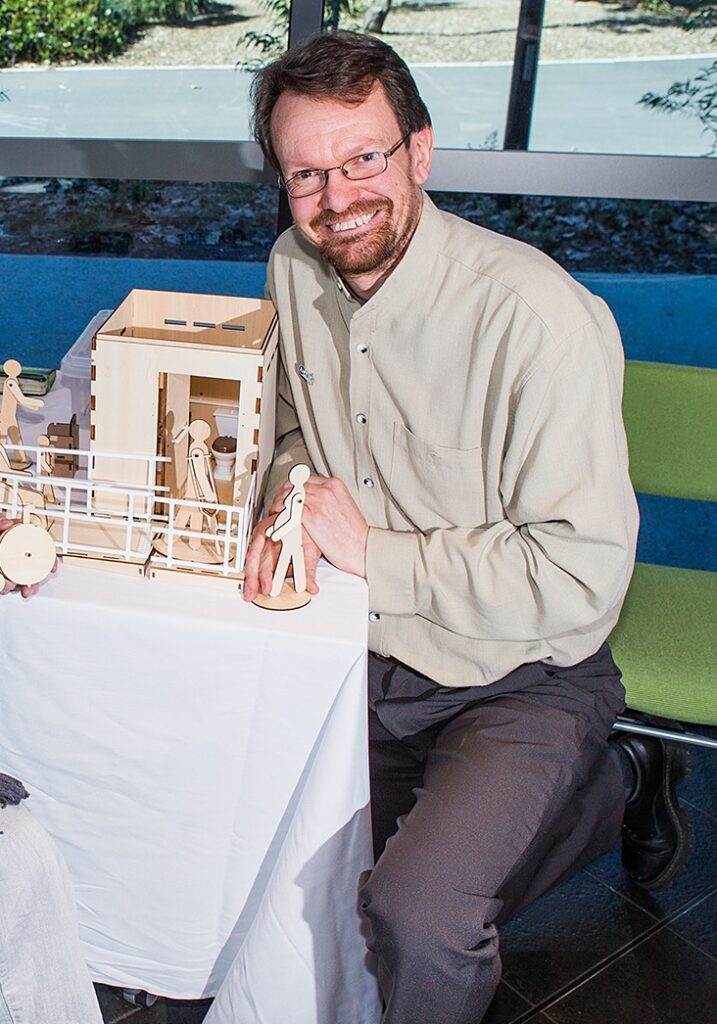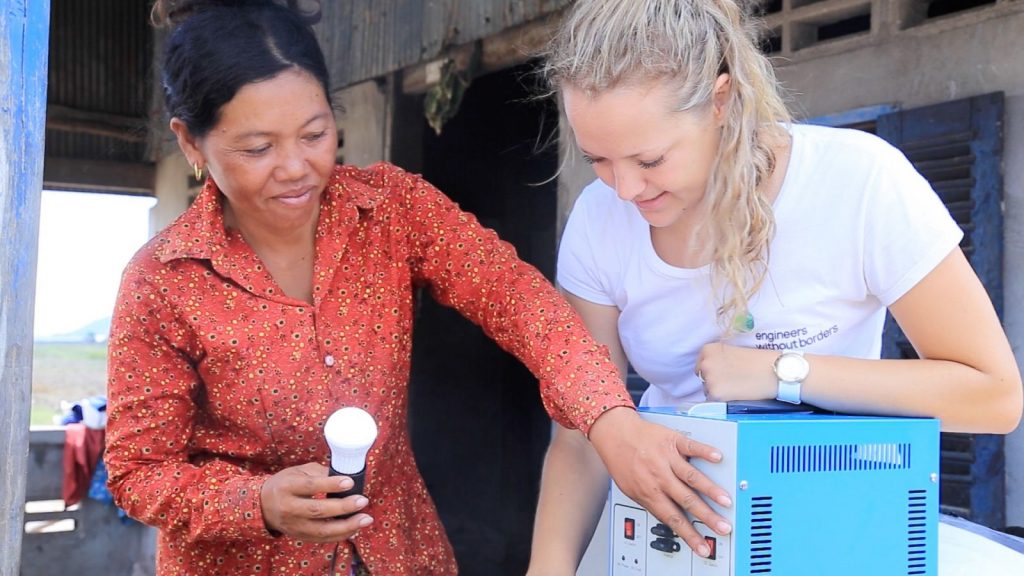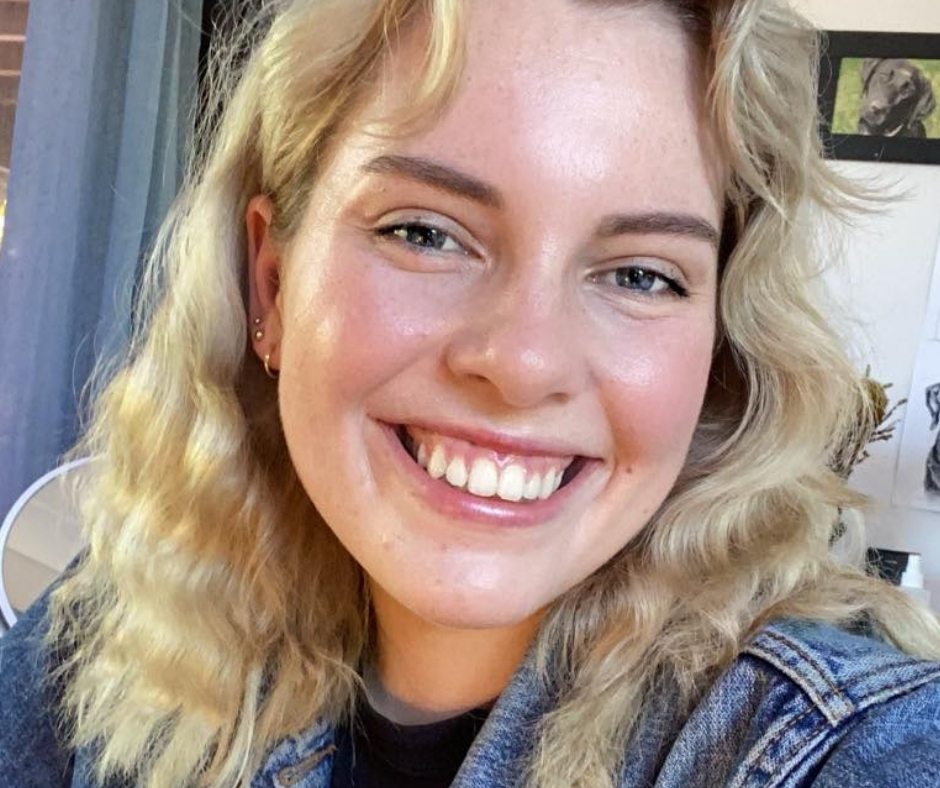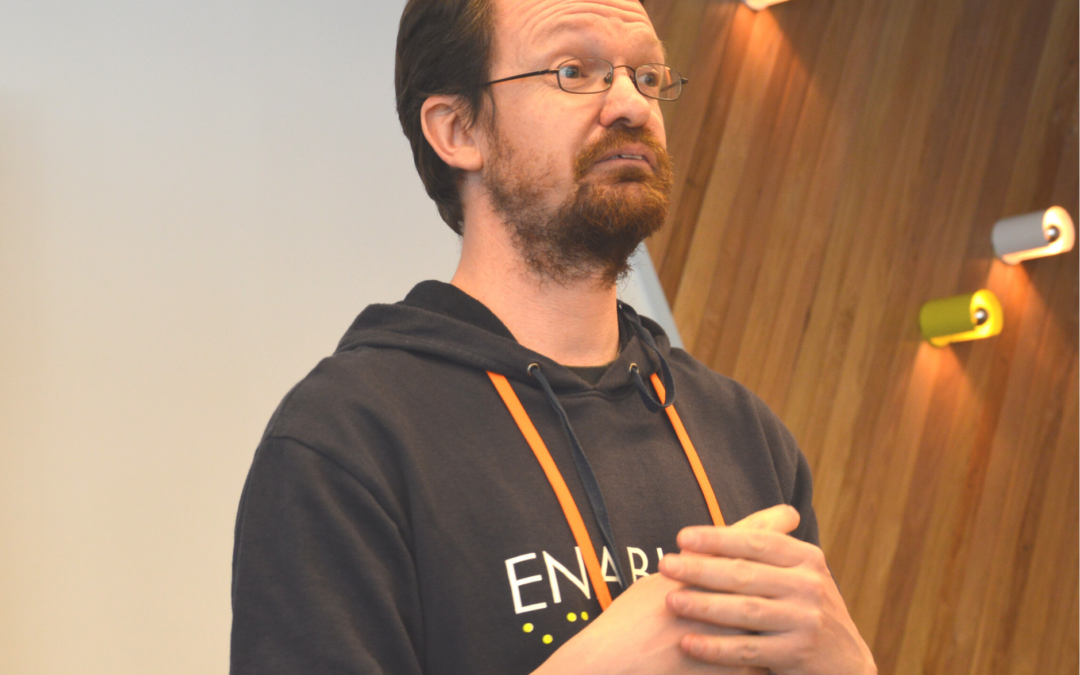It was a handwritten note, placed underneath the door of his office. “I am incredibly passionate about, and dedicated towards becoming, a humanitarian engineer!” it said. That was Orientation Week, 2019. It was one of those precious moments that made Australian National University (ANU) Senior Lecturer Jeremy Smith reflect on how far humanitarian engineering education had come, not only as a new way to study and practice engineering, but as a specific motivation for students to choose to study at ANU.
Jeremy himself had always had an interest in humanitarian causes. In 2005 as a research engineer working in the automotive and aerospace industries, he went along to a meeting of the fairly newly formed EWB ACT Chapter. He was interested in learning about EWB, but really didn’t see how it could apply to his area of work. Keen to show support of the Chapter, he attended the inaugural EWB National Conference. It was there, while listening to a speech about solar cookers in Malawi, that Jeremy had a lightbulb moment that would shape his career and the emergence of humanitarian engineering at ANU.
Lightbulbs, camera, action!
The speech, which talked about the need to involve local communities in co-designing solutions to local problems, aligned with what Jeremy had been working on in the automotive manufacturing sector. He realised his mindset was all wrong – his experience in systems engineering actually meant that he had lots to contribute.

Jeremy teaching at the ANU
Jeremy became an active chapter member, taking up the role of ACT Chapter Secretary and eventually President. He volunteered in the EWB office, which led to a role as a part-time member of EWB’s staff in the education team.
At that time, EWB had a handful of programs that were offered to universities – an undergraduate Research Program, the EWB Challenge and the School Outreach volunteering program. But Jeremy saw an opportunity to link these elements together more formally.
One Friday afternoon Jeremy sat down with his then colleague, Lizzie Brown, and together they developed a formal university partnership program. What they created that Friday afternoon became the foundation of ANU and EWB’s long-lasting partnership. It was also the catalyst for what has now become a multi-layered partnership program that engages universities across Australia and New Zealand each year.
The origin story
When Jeremy first pitched the formal university partnership program idea to ANU, the university saw the benefits straight away. At the same time that Jeremy took the proposal to ANU, Lizzie was pitching it to the University of Queensland. In 2010 the two universities became EWB’s first formal university partners. Jeremy says ANU was excited about the partnership because of EWB’s reputation in the social impact space.
“There weren’t many organisations in engineering or technology that had a national profile for doing that kind of engagement. It opened up new opportunities for students – both within the student experience and in what was being taught. It allowed ANU to open up how people view engineering,” reflects Jeremy.
ANU’s engineering undergraduate degree has a systems engineering basis. Jeremy says this basis made the inclusion of humanitarian engineering education easier. Not satisfied with initiating the partnership, Jeremy wanted to help actually implement it within the university. He was inspired to work out how to embed humanitarian engineering education at ANU, and completed a Graduate Certificate in Teaching and Learning to aid its implementation.
In 2015, ANU collaborated with EWB to offer the first dedicated later-year humanitarian engineering elective in Australia. In the same year, Jeremy started a PhD in humanitarian engineering education, which he says surfaced the evidence that has now spawned the exciting developments in humanitarian engineering education that we’re now seeing at other universities.

ANU alumn Becky Watts (right)
Two of the first students to graduate through the new humanitarian engineering final-year elective at ANU were Becky Watts and Darien Colbeck. Becky and Darien had been forging their own way before ANU had a formal minor on offer. Becky was inspired to take the humanitarian engineering pathway after participating in the EWB Challenge, where Jeremy, as lecturer, gave a talk on composting toilets. Becky’s undergraduate experience with ANU and EWB led to a role straight out of university as a Project Facilitator for EWB Australia’s Appropriate Technology initiative in Cambodia. Darien went straight to working for a local disability organisation. Seeing the kind of engineering vision that Becky and Darien were exploring through their first graduate positions was the moment when Jeremy thought: we’re onto something.
Today, the partnership with ANU is one of EWB’s longest and richest university partnerships. ANU now offers a formal minor in humanitarian engineering, which is attracting more and more socially conscious students.
A minor achievement
Adele van der Winden is one student who has taken up the minor. She was studying her undergraduate engineering degree at Queensland University of Technology (QUT), and was compelled to additionally complete the humanitarian engineering minor at ANU. Travelling from Brisbane for Canberra in 2019 turned out to be a great decision.
“The minor stood out at the time, as it’s quite rare for universities to offer an entire minor, or more, in humanitarian engineering. I was drawn to ANU’s Humanitarian Engineering minor for a variety of reasons, ranging from the wide selection of subjects it offers, to how well it would complement my QUT degree course structure,” says Adele.
For Adele, the course went beyond gaining technical engineering knowledge. She liked that it explored the fundamental issues behind the need for humanitarian engineering. ANU’s minor involves subjects in sociology and social sciences, which she says were initially intimidating. These subjects, though, ended up being a pivotal learning experience.
“They encouraged me to cultivate the critical thinking skills needed to understand the complexities and challenges of development, unpack global issues such as climate change and poverty, and really make me consider where my place – as someone hoping to work in this field – might be,” says Adele. “For engineers working in the humanitarian engineering space, it’s this contextual, non-technical knowledge which is perhaps less readily available to us – but no less critically important.”
With the humanitarian engineering minor under her belt, Adele was selected as a 2021 EWB Influencer Fellow, the perfect opportunity, to build on that foundation.
“The skills I gained from my minor, and the skills I am currently learning from the EWB Influencer Fellowship, I believe, will be abundantly formative in helping me choose and navigate my career path. For me, that career path is not yet well defined, but thanks to this minor and the Fellowship, I feel more informed and confident to make these decisions and am excited to work in a field I am so passionate about. I strongly feel these skills would greatly benefit all engineering students; and I would love to see more universities teach humanitarian and sustainable engineering,” says Adele.
A superstar chapter
The impact of the EWB ACT Chapter, which is mainly composed of ANU students and alumni, speaks to the strength of the partnership. The ACT Chapter cleaned up at the 2020 Danny Awards – EWB’s annual recognition of the most outstanding volunteers in EWB’s Chapter network. It was an impressive feat considering the ACT Chapter has the smallest membership base. Chapter President Louise Bardwell says that the chapter’s success comes down to the dedication of its members.

Sarah Callinan
When Louise’s predecessor, Sarah Callinan, started her role as ACT Chapter President in 2019 she had just three committee members. In her time as President, Sarah grew the size of the chapter’s executive, while encouraging alumni to remain involved and fostering a diverse and inclusive culture. She won the 2020 EWB Leader & Mentor Danny Award for her achievements in this space.
Along with Sarah’s award, Jess Weakley won the Newcomer Award for her dedication to generating greater awareness of humanitarian engineering. To cap it off, Elizabeth Elias and Briana Jones won the COVID-19 Adaption Award. Elizabeth and Briana were innovative in translating the School Outreach program from in-person to online.
Louise Bardwell says the impact of the School Outreach program is one of the great successes of the ACT Chapter.
“Through School Outreach and the many workshops we have facilitated in schools around the ACT, our chapter has grown both an understanding of, and passion for, humanitarian engineering. Especially in areas like sustainable development, climate change and women’s involvement in STEM, School Outreach plays an important role in teaching primary to high school aged students what a career in engineering could look like, and therefore how a degree in STEM provides them with the skills to solve important challenges facing communities,” says Louise.
Louise is another student that enrolled at ANU with humanitarian engineering in mind. She knew of ANU and EWB’s commitment to humanitarian engineering education and wanted to be involved. She sees the EWB and ANU partnership as one that broadens horizons and provides excellent project-based learning opportunities.
“The EWB/ANU humanitarian engineering partnership provides ANU students with ongoing and active engagement with EWB, extending a students’ university degree beyond just their studies, to practical community-focused projects. Across core ANU engineering courses, students are able to select humanitarian engineering-focused design projects. In these projects, students have the opportunity to employ the new engineering skills they are learning to real-world design challenges, allowing them to witness first-hand the meaningful impact that engineering can have in local communities.”
Humanitarian engineering education’s ‘generation next’
ANU’s humanitarian engineering alumni are the early adopters that are starting to shape the future of the sector. Liam Highmore, a 2019 ANU systems engineering graduate, won the Undergraduate Research Award at the Global Undergraduate Awards, for a thesis project that was part of the EWB Research Challenge.

Liam Highmore (centre)
For Jeremy Smith, the success of humanitarian engineering education at ANU, and the EWB partnership, is in seeing students like Liam become the next generation of leaders. Liam found the ANU and EWB partnership important in shaping his academic life, professional career and personal development.
Liam now works in telecommunications, but his interest in humanitarian activities remains strong. He is always looking at how he can apply his humanitarian engineering knowledge to make a positive impact. He says this is “something I’m not sure I would do, if it wasn’t for EWB and ANU”.
Incorporating his humanitarian engineering mindset in a traditional engineering role was initially challenging for Liam. But he has found he has been, mostly unconsciously, applying many humanitarian engineering principles into his work. Like his lecturer Jeremy Smith all those years ago, Liam sees how humanitarian engineering approaches mesh with ‘traditional’ engineering disciplines.
“Using a human-centred approach to customer problems, encouraging cross-disciplinary approaches which use a wide range of people and skills to get the most out of projects, and building capacity in other teams is similar to how we would if we were co-creating technology in a Cambodian community,” says Liam.
Liam is excited by the strides made in humanitarian engineering education across universities. The next step, he says, is translating that progress into the industry.
“I would love to see humanitarian engineering ‘professionalised’ as its own entity. Just like there will always be a need for structural or electrical engineers, I think there will always be a place for humanitarian engineers.”
With the ANU and EWB partnership clearly nurturing the future engineering leaders that we know the sector needs, the ability for the sector to redefine its role in addressing some of the world’s most wicked problems is possible – creating a world where technology benefits all.


